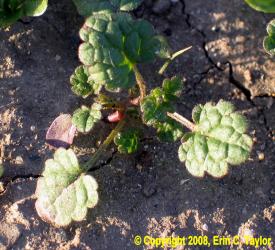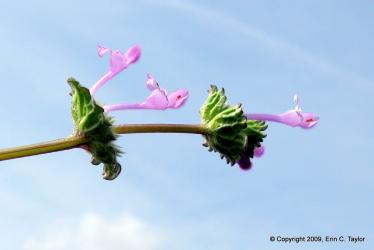Henbit

Henbit (Lamium amplexicaule L.)
Life Cycle:
Winter annual. Emerges in the mostly in the fall, but can have some emergence in early spring, flowering and seed set begins in early spring. Plants die with hot, dry weather in late-May and June.
Emergence:
Primarily emerges from soil depth of 1-inch or less. However, emergence can occur from 2 1/2-inch soil depths.
Seed:
Production Range: More than 2,000 seeds per plant.
Dispersal Mechanisms: None.
Longevity: Moderate persistence - seeds can remain viable for 25 to 40 years.
Dormancy: Initially dormant, high summer temperatures after ripen seed to break dormancy.

Competitiveness:
Not very competitive. Twenty-one henbit plants per yard2 did not reduce wheat yields. At 98 and 184 plants per yard2 winter wheat yields were reduced 13 and 38%, respectively.
Preferred Soil/Field Conditions:
Thrives in rich fertile soils - however, will also grow in light sandy soils.
Management:
Biological
Predation/grazing: Not preferred by grazing animals. Under high infestations henbit has caused some minor neurological problems in sheep, cattle, and horses.
Decay: No information.
Mechanical
Tillage: Tillage in early fall during the daytime can increase henbit germination. However, henbit seedlings are readily controlled by late-fall and early-spring tillage.
Rotary Hoeing: Primarily a no-till weed, not likely present at time of hoeing.
Flaming: No information.
Cultural
Crop rotation: Typically a problem of small grains, alfalfa and no-tillage systems. Planting small grains at higher populations will suppress henbit.
Planting date: Tillage in the spring and planting later (mid-May) will reduce henbit infestations.
Chemical
Application timing and effectiveness: Easily controlled with herbicides. Fall and early spring herbicide applications are generally most effective and may also suppress seed production. Keep in mind that there may be some spring emergence, so consider using a residual herbicide. Please refer to E-434, "MSU Weed Control Guide for Field Crops," for herbicide recommendations (www.msuweeds.com/publications).
Additional Information
Can serve as an alternate host for soybean cyst nematode, two-spotted spider mites, and tomato spotted wilt.



 Print
Print Email
Email